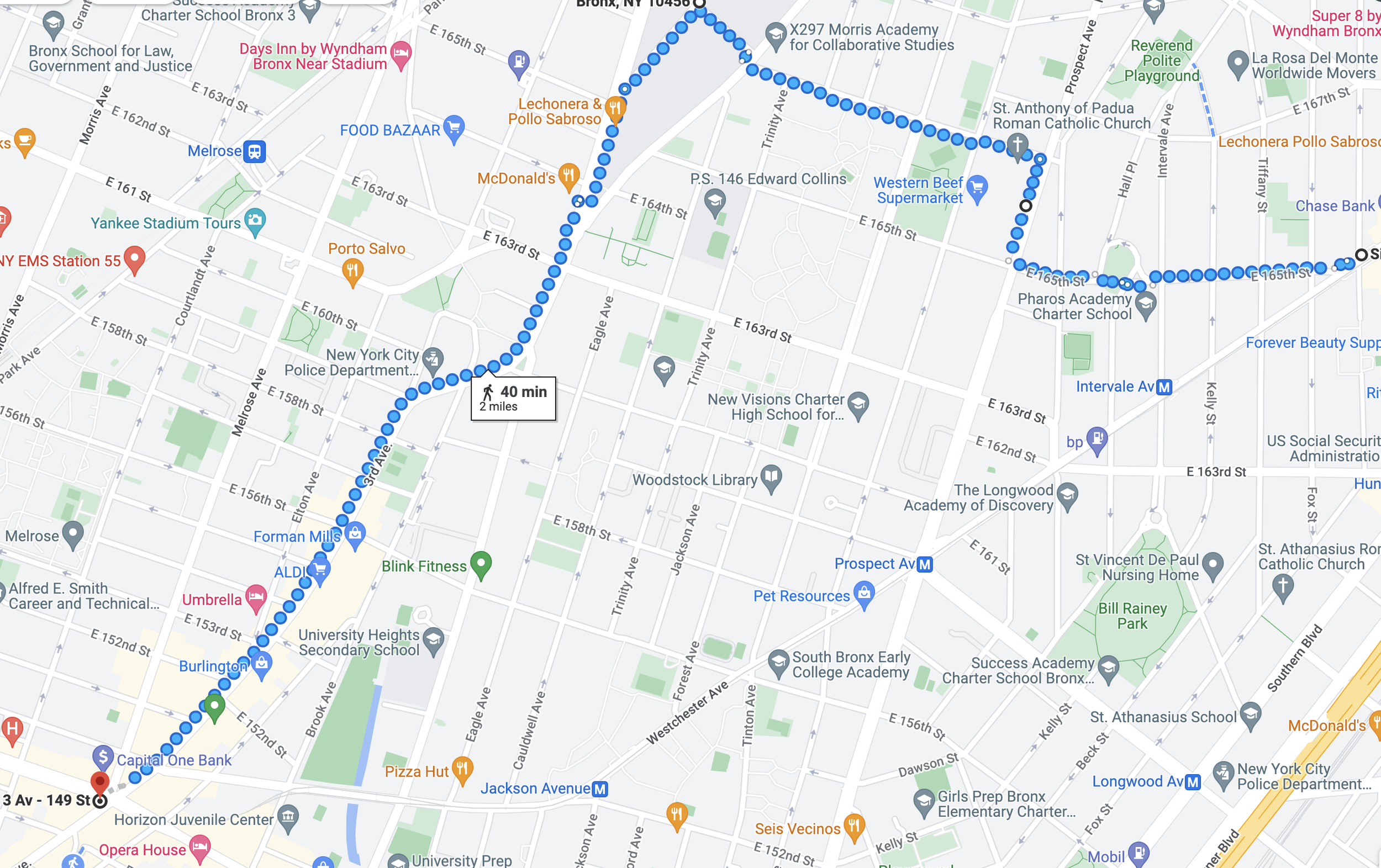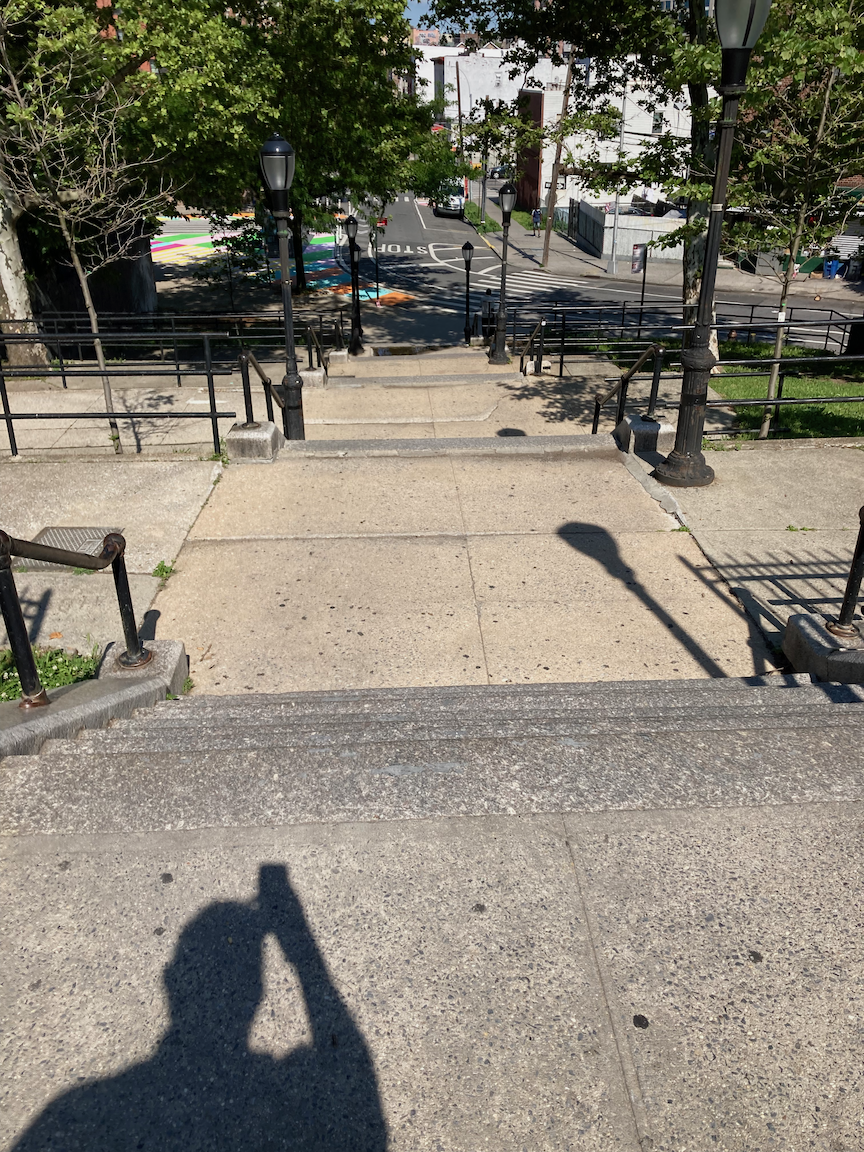Southern Bronx Wrap-Up, For Now
Route of this walk. Route reads from right to left.
WHERE: Stair street at East 165 Street, and two at Franklin Avenue at Third Avenue, Bronx
START: Simpson Street subway station (2 and 5 trains, fully accessible)
FINISH: 3 Avenue - 149 Street subway station (2 and 5 trains, fully accessible)
DISTANCE: 2.0 miles (3.2 kilometers)
Photographs by Michael Cairl except as noted. Maps courtesy Google Maps.
On my first stair streets walk in almost two months I decided to tackle the stair streets in the Southern Bronx that I hadn’t already done, under a brilliant blue sky. This included an extra short staircase I hadn’t known about previously. I started the trip at the accessible Simpson Street station, one I’ve visited before. It is in a busy commercial district. Crossing Westchester Avenue from the bottom of the elevator, I proceeded west on East 165 Street through a residential area to the first of the day’s stair streets, East 165 Street from Rogers Place up to Hall Place. This has 35 steps, some of which are uneven, with a handrail that is set too low. These stairs appear to be well used and should be repaired.
The amount of trees and green space I encountered, at least to Franklin Avenue, was a pleasant surprise, as was the notable architecture I saw. The first such building was St. Augustine Presbyterian Church at the corner of East 165 Street and Prospect Avenue. From www.urbanarchive.org:
St. Augustine Presbyterian Church, 1938. Image courtesy New York Public Library via urbanarchive.org.
This brick neo-Gothic church was constructed in 1906 for the Woodstock Presbyterian Church. That congregation occupied this building until it merged with the Home Street Presbyterian Church in 1938 and moved to their quaint wood-frame 1910 church at 1017 Home Street. Since 1938 the church [has] been owned by the St. Augustine Presbyterian Church, which was established that year. A popular community for African American and Puerto Rican neighbors, the church boomed during the 1940s and 1950s. The founder pastor, Elder Garnett Hawkins, was the first African-American moderator of the General Assembly of the United Presbyterian Church and active in the civil rights movement. St. Augustine is still an active congregation today.
From there I walked north on Prospect Avenue one block to East 166 Street and then west. Prospect Avenue is one of the city’s best on-street bike routes; I have biked it many times en route to the central and northern Bronx. This particular block has an ugly strip mall with a Western Beef supermarket and a Family Dollar store, both of which do a brisk business in this neighborhood.
Trinity Episcopal Church of Morrisania.
The next building to stop me in my tracks was the Trinity Episcopal Church of Morrisania, on East 166 Street. It opened in 1874 and has the look of a little country church. It probably was a country church at the time, but in the next thirty years a whole neighborhood was built around it, spurred by the Third Avenue Elevated and the IRT subway. If those walls could talk. I need to go back when it is open.
Across East 166 Street from the church is a block of row houses that would not look out of place in Brooklyn. Just west of the church, at East 166 Street and Boston Road, is the building that dominates the area, Morris High School, dating from 1902. Again from urbanarchive.org:
Founded in 1897 as Peter Cooper High School, the first co-educational high school in New York City, the building that today houses the Morris High School was built in 1902 and is considered to be one of architect C.B.J. Snyder’s masterpieces. Noteworthy is the school’s façade in the popular Collegiate Gothic Revival style which evokes the belief that education, ideals, and beauty should be equally available to all students regardless of their neighborhood.
Morris High School. Photo courtesy New York Landmarks Conservancy (Jerry Spearman, photographer) via urbanarchive.org.
In one of the finest interiors of any New York City school, Morris High has an elaborate 800-seat auditorium featuring Tudor arches, stained glass windows, highly decorative Gothic elements, and a W.W. Kimball Co. pipe organ. The auditorium was restored in 1991 and today is known as Duncan Hall.
Among her famous alumni [are] Armand Hammer (industrialist), Milton Berle (comedian), and General Colin Powell (former U.S. Secretary of State). In 1982, the school building along with the surrounding area was designated as the Morris High School Historic District and in 1983 was listed on the National Register of Historic Places.
But wait, there’s more! Across Boston Road from Morris High is the 58th Regiment Armory. One can imagine archers shooting arrows from the narrow windows. At other great armories of the period (late 19th century and early 20th century), like Kingsbridge in the Bronx and Pacific in Brooklyn, one can imagine the hapless invaders being met with both arrows and boiling oil. Beyond the fearsome façade of each of these armories is a vast drill hall for the Army regiment headquartered there.
58th Regiment Armory, 1906-1911, addition 1926-1928.
A short distance south on Franklin Avenue are the remaining two stair streets on today’s walk, forming two sides of the Franklin Triangle. The north side is 17 steps in decent condition. Near the angle opposite these steps, on the hypotenuse (Franklin Avenue), are 9 steps with a handrail only on one side.
I continued the walk on Third Avenue. Until 1973 the Third Avenue Elevated cast the street in perpetual shadow. The street from Franklin Avenue south to the Hub (East 149 Street) is a unfortunate mishmash of old and new buildings, most of them undistinguished at best except for two: the former Bronx Borough Court House (1905-1915) at East 161 Street (image at left below) and the 42nd Precinct (1904, image at right below) just south of there. The 42nd Precinct was used in the 1981 film Fort Apache: South Bronx as the stand-in for the 46th Precinct on Simpson Street, which was known then as Fort Apache. South of East 156 Street is the lively commercial district that the Hub has long been. North of there, Third Avenue is drab but the portion of the avenue on this walk is quite the ethnic mosaic: African-American, West African, Afro-Caribbean, Puerto Rican, Mexican, Middle Eastern, and I’ve probably missed some. The street might not look like much but there’s a lot of life there.
Profile of this walk.
This walk was not a long one, or particularly hilly, but it was a good reboot of this series of walks after a fall seven weeks before (see the post “Sometimes I Stumble” on the “Other Walks Around Town” page). The streetscape was a pleasant surprise and passers-by sometimes would smile as I walked past.
Stair recap:
East 165 Street: 35 steps up
Franklin Triangle, short leg: 17 steps down
Franklin Triangle, hypotenuse: 9 steps up and 9 steps down
Total 70 steps
Total stair streets to date: 105, not counting repeat climbs of certain streets, with 15 to go (4 in the Bronx, 4 in Manhattan, 7 on Staten Island) before I repeat the cycle.











